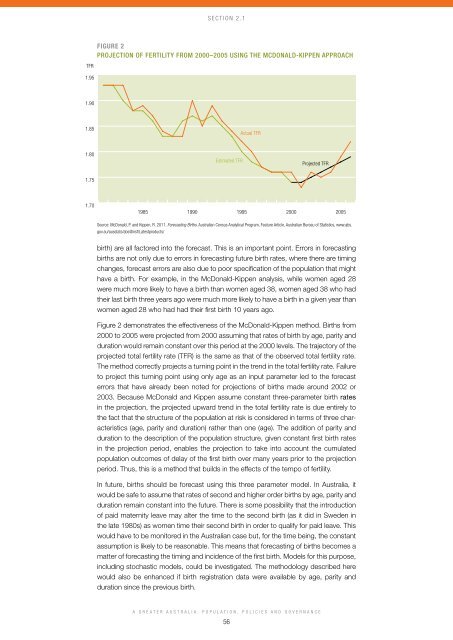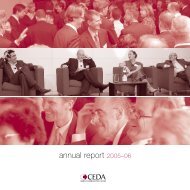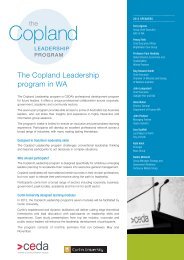A Greater Australia: Population, policies and governance - CEDA
A Greater Australia: Population, policies and governance - CEDA
A Greater Australia: Population, policies and governance - CEDA
- No tags were found...
You also want an ePaper? Increase the reach of your titles
YUMPU automatically turns print PDFs into web optimized ePapers that Google loves.
Section 2.1Figure 2projection of fertility from 2000–2005 using the McDonald-Kippen ApproachTFR1.951.901.85Actual TFR1.80Estimated TFRProjected TFR1.751.7019851990199520002005Source: McDonald, P. <strong>and</strong> Kippen, R. 2011. Forecasting Births. <strong>Australia</strong>n Census Analytical Program, Feature Article, <strong>Australia</strong>n Bureau of Statistics, www.abs.gov.au/ausstats/abs@nsf/Latestproducts/birth) are all factored into the forecast. This is an important point. Errors in forecastingbirths are not only due to errors in forecasting future birth rates, where there are timingchanges, forecast errors are also due to poor specification of the population that mighthave a birth. For example, in the McDonald-Kippen analysis, while women aged 28were much more likely to have a birth than women aged 38, women aged 38 who hadtheir last birth three years ago were much more likely to have a birth in a given year thanwomen aged 28 who had had their first birth 10 years ago.Figure 2 demonstrates the effectiveness of the McDonald-Kippen method. Births from2000 to 2005 were projected from 2000 assuming that rates of birth by age, parity <strong>and</strong>duration would remain constant over this period at the 2000 levels. The trajectory of theprojected total fertility rate (TFR) is the same as that of the observed total fertility rate.The method correctly projects a turning point in the trend in the total fertility rate. Failureto project this turning point using only age as an input parameter led to the forecasterrors that have already been noted for projections of births made around 2002 or2003. Because McDonald <strong>and</strong> Kippen assume constant three-parameter birth ratesin the projection, the projected upward trend in the total fertility rate is due entirely tothe fact that the structure of the population at risk is considered in terms of three characteristics(age, parity <strong>and</strong> duration) rather than one (age). The addition of parity <strong>and</strong>duration to the description of the population structure, given constant first birth ratesin the projection period, enables the projection to take into account the cumulatedpopulation outcomes of delay of the first birth over many years prior to the projectionperiod. Thus, this is a method that builds in the effects of the tempo of fertility.In future, births should be forecast using this three parameter model. In <strong>Australia</strong>, itwould be safe to assume that rates of second <strong>and</strong> higher order births by age, parity <strong>and</strong>duration remain constant into the future. There is some possibility that the introductionof paid maternity leave may alter the time to the second birth (as it did in Sweden inthe late 1980s) as women time their second birth in order to qualify for paid leave. Thiswould have to be monitored in the <strong>Australia</strong>n case but, for the time being, the constantassumption is likely to be reasonable. This means that forecasting of births becomes amatter of forecasting the timing <strong>and</strong> incidence of the first birth. Models for this purpose,including stochastic models, could be investigated. The methodology described herewould also be enhanced if birth registration data were available by age, parity <strong>and</strong>duration since the previous birth.A <strong>Greater</strong> <strong>Australia</strong>: <strong>Population</strong>, Policies <strong>and</strong> Governance56





